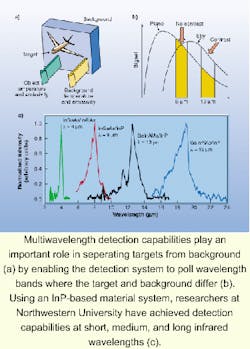Infrared Detectors: Researchers aspire toward artificial eyes
With funding support from the US Defense Advanced Research Projects Agency (DARPA) and the Air Force, researchers at Northwestern University (Evanston, IL) are developing "artificial eyes" based on multispectral quantum-well infrared photodetectors (QWIPs). Manijeh Razeghi, who directs the Center for Quantum Devices at Northwestern, describes the process as taking several stages, including producing the QWIPs themselves in focal-plane arrays (FPAs), integrating detectors onto silicon substrates with other circuitry, and developing quantum-cascade laser sources.
In a presentation earlier this year at Photonics West, Razeghi's team described the growth of QWIPs based on a gallium indium arsenide phosphide/indium phosphide (GaInAsP/InP) material system using low-pressure metal-oxide chemical-vapor deposition (LP-MOCVD). The research team chose to work with GaInAsP/InP instead of the commercially popular aluminum gallium arsenide/gallium arsenide (AlGaAs/GaAs) material to avoid "DX-center traps, high-temperature-growth requirements, oxidation, and other difficulties associated with the use of materials containing aluminum," according to Razeghi.
The growth temperature in the LP-MOCVD reactor was 480°C, and the pressure was 78 Torr. An n-type dopant (silane) was used to facilitate intersub-band absorption in the materials and detection of signals longer than 14 µm, which is particularly important for Air Force applications in the cold upper atmosphere, Razeghi said (see figure).
After epitaxy, 400 x 400-µm mesas were patterned into FPAs using an electron cyclotron resonance-enhanced reactive ion-etched reactor. Then Ti/Pt/Au metal contacts were deposited in an electron-beam evaporation step. Devices designed for 9-µm cutoff were tested at a temperature of 80 K and yielded a best-case responsivity of 33.2 AW-1 at a bias of 5 V. The device operated with a detectivity of 3.5 x 10-10 cm Hz-1/2W-1 at a bias of 0.75 V. 1
To fully exploit the QWIP FPA technology, Razeghi's group is also working to implement it in a monolithic chip set with silicon-based readout integrated circuits using a complementary metal-oxide semiconductor process. Her team also reported on this work in a separate presentation at Photonics West.
Last month at CLEO, the Northwestern group was chosen to present a postdeadline paper for its demonstration of high output powers in quantum-cascade lasers (semiconductor lasers based on intersub-band transitions within conduction band quantum wells).2 The quantum-cascade laser work in Razeghi's group is funded by DARPA through the US Army. The research group reported peak output of 1.2 W at 9 µm and room temperature and a threshold current density as low as 1.83 kA/cm2. High operating temperatures of 160 K for continuous-wave and 400 K for pulsed operation were also obtained. At 11 µm, a high peak power of 200 mW was obtained at room temperature. "This is a very important result for the QWIP," Razeghi said, "because you need these kinds of lasers as well [for cold-body detection]."
REFERENCES
- M. Erdtmann et al., Appl. Phys. Lett. (in press).
- M. Razeghi, CLEO 2000 postdeadline paper.
About the Author
Hassaun A. Jones-Bey
Senior Editor and Freelance Writer
Hassaun A. Jones-Bey was a senior editor and then freelance writer for Laser Focus World.
